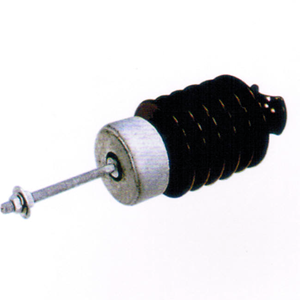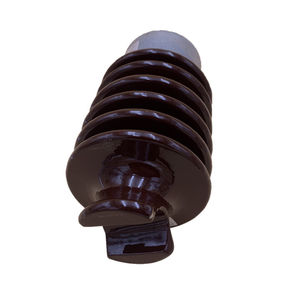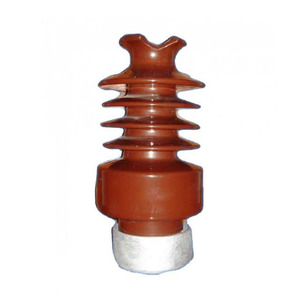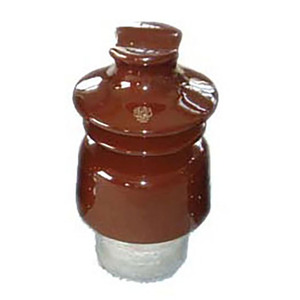(202 products available)


























































































































































Porcelain post-type insulators are important in electrical systems. They ensure that conductors stay at the right distance from each other. The different types of these insulators include suspension insulators, strain insulators, and others that help to fit each specific need and condition.
These insulators hang the power lines from the supporting structures, such as wooden or metal poles. They are used when the power lines are straight or when they don’t have much tension put on them. Suspension insulators are made up of a few porcelain insulator pieces connected in series to increase the voltage capacity of the insulator. The more insulator pieces there are in a chain, the higher the voltage the insulator can handle. This design means that even if there is a lot of electric force trying to pull the wires away from the supports, the insulators can keep the wires safely in place.
These are used where there is more tension on the wires, such as at the ends of power lines or where the lines need to be connected to large electrical towers. They can withstand greater pulling forces due to their construction. Strain insulators are necessary for securing the power lines against excessive mechanical stresses caused by wind, ice buildup, or other environmental factors.
These are mounted on the cross-arms of poles and are used mainly in low-voltage distribution networks. They are smaller, lighter, and designed for lower voltage applications. With a simple structure, several can be used at once to support the lines from a single cross-arm.
These are installed around the edges of the insulator to provide additional protection from flashover. Flashover is where electricity jumps from one conductive part to another. Guard rings help prevent this by giving the electrical current a longer path to travel.
These are made of a single piece of porcelain and are generally used in low-voltage applications. High-voltage applications need insulators that are made of many connected pieces, but for less powerful lines, a single insulator can provide all the necessary support.
They also need to be tough enough to withstand long-term mechanical stress from things like strong winds, heavy ice, and the weight of the power lines themselves. The more durable the insulator, the less need there is for frequent maintenance or replacements.
This is the most common material used to make post-type insulators due to its excellent properties as an electrical insulating material. It is obtained by firing a mixture of clay, quartz, and feldspar at very high temperatures, around 1200-1400 °C. This process forms a dense, hard material that has a shiny glass-like surface. This surface is very smooth and helps prevent dirt and dust from building up, which could allow electricity to jump from the wire to the pole.
Some post insulators are made of toughened glass. Glass provides some benefits, like being transparent, which allows any dirt or pollution to be easily washed off by the rain. This keeps the insulators cleaner and reduces the risk of flashover. Glass also has very good mechanical strength and maybe slightly more withstand electrically than porcelain. However, it does not have the opaque finish of porcelain, making it harder to detect cracks.
In some cases, post-type insulators also have metal parts. These include galvanized steel or aluminum bolts, ties, and supporting hardware. Properly sealing these metal areas from exposure to moisture and corrosive elements is important.
For insulators intended for particularly harsh conditions, such as areas prone to severe storms or icing, additional strengthening materials may be used. These include fiber-reinforced composites. Insulators made of such materials have added durability and are less likely to crack or break.
Porcelain post-type insulators have many important uses to make sure electrical systems work safely and effectively. Wherever there are high voltages or long power lines, these insulators play a key role in preventing problems. From protecting substation equipment to supporting transmission lines over difficult terrain, they are essential in many different environments.
The main use of porcelain post-type insulators is to keep high-voltage power lines safely away from towers, poles, and each other. This prevents electrical arcing or "flashover," where electricity jumps to the nearest grounded object. The insulators also support the physical weight of the lines and withstand any forces from wind, ice, or the line's tension. The smooth, durable surfaces of porcelain prevent electricity from jumping the line to other parts of the system.
Insulators in substations help suspend and separate incoming and outgoing high-voltage transmission lines from other equipment. This ensures there is no chance of wires accidentally coming into contact with circuit breakers, transformers, and other high-voltage devices. Post-type insulators for substations must have very good insulation properties. They also have huge electrical capacity to withstand the voltages seen in these areas.
Post-type insulators are also used in manholes and vaults to protect underground copper cables from electric current. With many cables close together, having insulators separating them helps prevent interference between the wires. This insulator improves the reliability of power delivered to homes and businesses.
Porcelain post-type insulators are widely used on electrified rail systems. The poles or tracks carry high-voltage wires to feed the trains. The insulators are mounted on the track or rails to keep the wires insulated from the metal track. This provides a pathway for electric current. Without insulators, the system could short-circuit, stopping power delivery and potentially causing safety problems.
People in the electrical and utility industries must consider the following factors when choosing a porcelain post-type insulator. These factors influence the insulator's performance, safety, and lifespan in various settings.
Insulators must have high electrical insulation to prevent flashover and short circuits. This is particularly important for high-voltage transmission lines and substation applications. Insulators can be tested to verify their insulating capacity. The tests measure how much voltage the insulator can handle before breakdown. Statutory regulations also require minimum levels to ensure safety.
Insulators also need to have enough mechanical strength to support not just their weight but the weight of the lines and environmental factors like wind or ice. If they break, it could cause major system failures or safety hazards. When selecting them, professionals look at load data, including breaking loads and maximum allowable loads, to ensure the insulator can withstand the forces it will see in real-world conditions.
The insulator must be able to endure high electrical loads without overheating. Excessive surges or continuous current could cause the material to warp or crack, compromising its insulating ability. This can be a concern in areas with very hot temperatures or where lines carry extremely high currents. Insulator materials must be able to withstand these thermal stresses over time.
The insulator must be able to survive other environmental conditions that could degrade it. These include pollution, temperature cycling, and humidity. Professionals ensure proper selection to avoid materials that are prone to chemical degradation or that have surfaces that could permit moisture creep. This insulator will require less maintenance and will be more reliable.
Insulator maintenance is key in keeping the electrical systems operational. Professionals often consider whether the insulators have cleanable surfaces or require frequent inspection and repair. For example, any accumulation of dust or other contaminants will have to be addressed. Knowing the maintenance needs helps utility managers make decisions to keep the system reliably functioning with minimal downtime for manual work.
A1: These insulators prevent flashover by ensuring conductors maintain the correct distance from each other. Flashover is where electricity jumps from one conductor to another. Insulators also support the weight of the lines.
A2: Porcelain insulators are fairly low-maintenance. Their smooth, durable surfaces prevent dirt accumulation. Alloy parts also do not require much maintenance.
A3: Yes, glass is also toughened to make it a glass option for electrical post insulators. Reinforced composites may also be used for insulators to be placed in harsh conditions.
A4: They are mainly concerned with the insulator's ability to hold electrical load without causing flashovers and mechanical support of the lines. Environmental condition endurance is also considered.
A5: Yes, they are designed to withstand all environmental conditions, including storms. Designs include additional materials like composite fibers for extra strength for these harsh conditions.